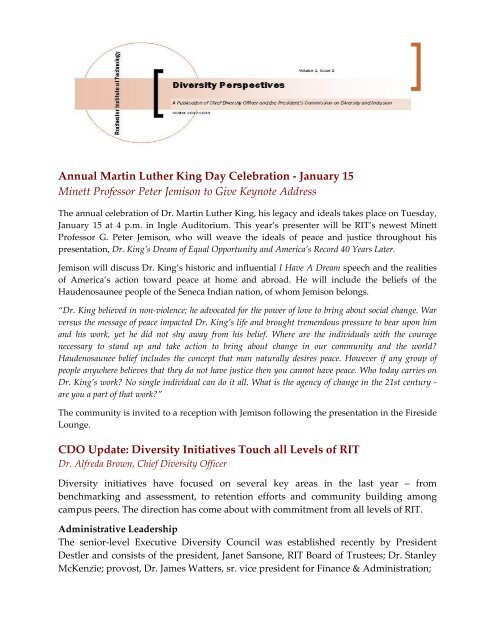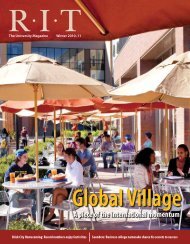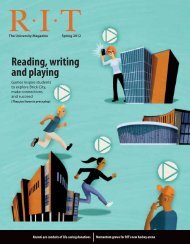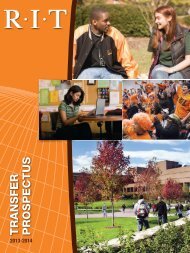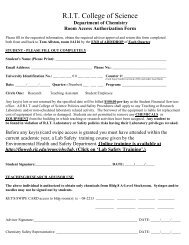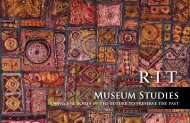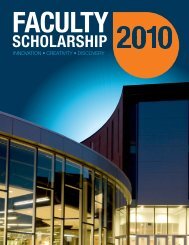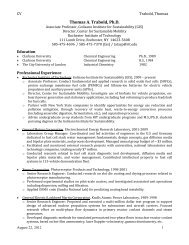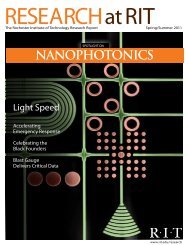Annual Martin Luther King Day Celebration - January 15 Minett ...
Annual Martin Luther King Day Celebration - January 15 Minett ...
Annual Martin Luther King Day Celebration - January 15 Minett ...
You also want an ePaper? Increase the reach of your titles
YUMPU automatically turns print PDFs into web optimized ePapers that Google loves.
<strong>Annual</strong> <strong>Martin</strong> <strong>Luther</strong> <strong>King</strong> <strong>Day</strong> <strong>Celebration</strong> ‐ <strong>January</strong> <strong>15</strong><br />
<strong>Minett</strong> Professor Peter Jemison to Give Keynote Address<br />
The annual celebration of Dr. <strong>Martin</strong> <strong>Luther</strong> <strong>King</strong>, his legacy and ideals takes place on Tuesday,<br />
<strong>January</strong> <strong>15</strong> at 4 p.m. in Ingle Auditorium. This year’s presenter will be RIT’s newest <strong>Minett</strong><br />
Professor G. Peter Jemison, who will weave the ideals of peace and justice throughout his<br />
presentation, Dr. <strong>King</strong>’s Dream of Equal Opportunity and America’s Record 40 Years Later.<br />
Jemison will discuss Dr. <strong>King</strong>’s historic and influential I Have A Dream speech and the realities<br />
of America’s action toward peace at home and abroad. He will include the beliefs of the<br />
Haudenosaunee people of the Seneca Indian nation, of whom Jemison belongs.<br />
“Dr. <strong>King</strong> believed in non‐violence; he advocated for the power of love to bring about social change. War<br />
versus the message of peace impacted Dr. <strong>King</strong>’s life and brought tremendous pressure to bear upon him<br />
and his work, yet he did not shy away from his belief. Where are the individuals with the courage<br />
necessary to stand up and take action to bring about change in our community and the world?<br />
Haudenosaunee belief includes the concept that man naturally desires peace. However if any group of<br />
people anywhere believes that they do not have justice then you cannot have peace. Who today carries on<br />
Dr. <strong>King</strong>’s work? No single individual can do it all. What is the agency of change in the 21st century ‐<br />
are you a part of that work?”<br />
The community is invited to a reception with Jemison following the presentation in the Fireside<br />
Lounge.<br />
CDO Update: Diversity Initiatives Touch all Levels of RIT<br />
Dr. Alfreda Brown, Chief Diversity Officer<br />
Diversity initiatives have focused on several key areas in the last year – from<br />
benchmarking and assessment, to retention efforts and community building among<br />
campus peers. The direction has come about with commitment from all levels of RIT.<br />
Administrative Leadership<br />
The senior‐level Executive Diversity Council was established recently by President<br />
Destler and consists of the president, Janet Sansone, RIT Board of Trustees; Dr. Stanley<br />
McKenzie; provost, Dr. James Watters, sr. vice president for Finance & Administration;
Dr. Jim Miller, sr. vice president for Enrollment Management & Career Services; and Dr.<br />
Mary Beth Cooper, vice president for Student Affairs. The group will monitor RIT’s<br />
progress in reaching the broad goal of attracting a diverse group of students, faculty,<br />
and staff to the RIT community. Also established was the Council on Diversity and<br />
Inclusion, consisting of campus‐wide representatives charged with developing all<br />
resources and data that RIT will benchmark against. Work began by looking at many<br />
areas including recruitment and retention, curriculum and career preparation, the<br />
administration of a climate study, and preparing a university scorecard.<br />
In 2008 leadership will focus on the development of an Equity Scorecard for RIT. The<br />
University’s diversity strategic goal states: “RIT will facilitate a campus climate where<br />
the value of diversity and its importance in creating a sense of community is recognized<br />
and appreciated.” There are two diversity strategic objectives that align with the Equity<br />
Scorecard Project: “RIT will continue to support and expand the university’s programs<br />
to diversify and build community,” and “RIT will continue to review the status of<br />
women.” The underrepresented populations of African Americans, Latino Americans,<br />
Native Americans and women at RIT are the focus areas of the Equity Scorecard project.<br />
We are committed to fostering a campus environment where human differences are not<br />
only recognized and appreciated, but leveraged to achieve the highest level of<br />
performance.<br />
The scorecard, a diversity assessment tool, is designed for higher education to narrow<br />
the achievement gap for specific populations, resulting in equitable outcomes for those<br />
historically underrepresented. Baseline data are provided, metrics and timelines are<br />
established, and results will be monitored by the leadership of the colleges and<br />
divisional units. Individualized improvement goals will be established and each college<br />
and division will be held accountable for achieving diversity‐based equitable outcomes.<br />
Data and information will be shared with campus through forums, meetings with<br />
governance groups and college/department meetings. RIT’s commitment to diversity is<br />
firm as we make an impact on the global economy as well as our more personal global<br />
village.<br />
Global Leadership Certificate Program ‐ Second Year<br />
New program added to RIT Leadership Institute<br />
With the recent news of RIT ‐ Dubai, the University’s latest foray into the ‘global village’, our<br />
ability to connect with individuals of another culture for academics, business, and a sense of<br />
community is more important than ever. One way for RIT students to make this important step<br />
is through the RIT Leadership Institute (RITLI). The Global Leadership Certificate Program, the<br />
newest certificate program in the RITLI, opened its second year with more participants and<br />
equal enthusiasm.<br />
“The program was created a year ago to help students prepare for communicating, working,<br />
learning, and living within the rich cultures around the globe,” said Sandy Whitmore, assistant
to the chief diversity officer. Along with Molly McGowan, director of the Leadership Institute,<br />
Whitmore developed the program designed to provide students with the tools to be effective<br />
leaders, communicate well cross‐culturally, and to understand the role of culture in decision‐<br />
making.<br />
The program consists of three components: mentoring, global awareness, and leadership.<br />
Students are partnered with another student from a different ethnic or cultural background and<br />
with a faculty/staff member. The three members meet several times over the course of the<br />
academic year to discuss issues around leadership, understanding cultures, stereotypes, and<br />
how to resolve barriers in communication.<br />
“In the last several years, we tried to get students involved in the Partnerships in Pluralism<br />
Program,” said Whitmore. “With their class and work schedules, they could not often attend the<br />
different cluster meetings. We wanted to include them in the diversity programs and they<br />
wanted to be involved on order to have a chance to discuss some of the diversity issues they<br />
were facing day‐to‐day. We just had to adjust the program to better meet their time schedules.”<br />
Leadership Institute workshops take place in the evenings, on weekends, and on occasion,<br />
during a quarter break. This allows for the meetings between students and their faculty or staff<br />
mentor to take place between classes, or on lunch hours during the week. As with many of the<br />
Leadership Institute programs, the edge given to the students completing certificates is two‐<br />
fold. “They learn communication, negotiation, cultural skills, and information that will serve<br />
them both personally and professionally,” Whitmore added.<br />
See http://www.rit.edu/leadership for more information.<br />
Partnerships in Pluralism Broadens Cultural Understanding<br />
Cultural differences are both reality and perception. Individuals view cultures not their own as<br />
different, mysterious, and sometimes in a positive or negative light. As RIT’s Partnerships in<br />
Pluralism Program enters its fourth year, it has become a way to bridge reality and perception.<br />
Bringing together diverse faculty and staff for one‐on‐one conversations about who they are as<br />
individuals, participants gain a perspective on how each make up the cultural fabric of a global<br />
village like RIT.<br />
With more than 80 partners in the first year of the program, Partnerships in Pluralism continues<br />
to grow and reach many. More than 170 people have completed the program and 50 more will<br />
participate this year. The interaction takes place in large group sessions, smaller working<br />
groups with sets of pairs and coaches, and individual pair meetings. For bi‐monthly meetings<br />
the pairs are given talking points as conversation starters and, as they progress through the<br />
program, they will pass through four phases designed to explore more in depth topics<br />
surrounding diversity, their differences and similarities.<br />
Partners are selected each year based on race/ethnicity, department affiliation, job position,<br />
faculty rank and discipline and care is taken to match similar functions or status. Participants<br />
volunteer for the year‐long program that allows learning to unfold over time while answering<br />
the questions: who are we, where are we, where do we want to be, and what will we do as<br />
individuals and with others to make a difference?
Ultimately, making a difference is the goal. The pairs will have the opportunity in a safe,<br />
confidential format, to explore differences at a deeper level. Sometimes stereotypes are believed<br />
as truths, and with information from personal stories, understanding and time, the stereotypes<br />
can be diminished. “It is early in the process for me but I am already enjoying the meetings with<br />
my partner, Sonia,” said current participant, Stacy DeRooy, a member of RIT Public Safety<br />
team. “We have begun to explore some deep topics and it’s all about being open and accepting.<br />
I have great expectations and look forward to the growth of our friendship.”<br />
The Partners in Pluralism program is an enriching experience for faculty and staff. The<br />
program has grown year after year, some returning as coaches to new participant groups. Each<br />
successive group broadens the circle of influence and inclusion.<br />
Commission Begins 2008 ‐ New Name and Renewed Commitment<br />
RIT has a long history of recognizing the contributions and strengths of its culturally‐rich<br />
students, faculty, and staff. Out of that richness grew the Commission for Promoting Pluralism.<br />
The Commission launches into 2008 with a new name –President’s Commission on Pluralism<br />
and Inclusion, but equally strong in its direction for including and recognizing strength in<br />
diversity.<br />
After nearly <strong>15</strong> years, Commission programs, events, and scholarships have become important<br />
to the campus‐at‐large. The name change reflects the growth of the organization under the<br />
umbrella of the new position of chief diversity officer. It will continue its mission of ensuring<br />
that people have an understanding of how they will work, live, and learn within the global<br />
village.<br />
President Destler spoke with Commission chairman, Thomas Warfield recently about his views<br />
on diversity at RIT, the role of the Commission and some anecdotes about how diversity has<br />
touched his life personally:<br />
Thomas Warfield: Diversity is a new ʺbuzzʺ word today; does it name a new way of thinking<br />
and lead to a new way of interaction or has it become so passé and meaningless for most people<br />
to take it seriously?<br />
Dr. Destler: The word ʺdiversityʺ is usually employed to advocate for a tolerant, inclusive, accepting<br />
community that respects and celebrates the differences between people of different races, ethnicities,<br />
genders and sexual orientations. It is this inclusiveness that brings power to the word, and it is the<br />
characteristic which I embrace most personally.<br />
TW: What might you say to those who see the diversity perspective as a way of avoiding the<br />
really difficult issues we face such as racism, sexism, homophobia and able‐ism?<br />
Dr. Destler: One cannot work for a more diverse community without confronting these challenges, and<br />
one cannot honestly advocate for diversity without recognizing the work that needs to be done to address<br />
these issues.<br />
TW: Can you tell us how diversity has played a role in your career and/or personal life?<br />
Dr. Destler: My father was fired from what is now Georgia Southern University in the late 1930ʹs for<br />
advocating the admission of African‐Americans. His example, which I learned about only when I became
an adult has taught me that one personʹs actions, taken together with those of many others, can<br />
eventually make a difference in our shared pursuit of a more equitable society. I am committed to do my<br />
part to help build a model of an equitable diverse community at RIT.<br />
TW: Pluralism is about creating a culture where each individual can thrive and contribute as a<br />
valued member of a larger community. In what ways do you see RIT as a leader in building a<br />
more welcoming pluralistic campus?<br />
Dr. Destler: RIT has much to be proud of in this area, but much remains to be done. We need to work on<br />
minority employee and student retention issues, to hold managers accountable over time for building a<br />
more diverse community, and we need to do more to ensure that faculty, staff, and, most importantly,<br />
students benefit from the diversity of our campus.<br />
TW: What do you see as the most challenging aspects and complexities of an increasingly<br />
diverse academic community and what steps do you think need to be taken to meet such<br />
challenges here at RIT?<br />
Dr. Destler: RIT is still an institution with a technical focus, and attracting minority students to<br />
technical fields remains a challenge. One way of addressing this problem over the long term is for us to<br />
become more involved in the K‐12 sector. Another way is for RIT to improve the retention of our minority<br />
faculty, staff, and student populations, thereby sending a message to these communities that they can<br />
succeed here.<br />
DIVERSITY PERSPECTIVES is published quarterly by the chief diversity officer, in conjunction with RIT’s<br />
President’s Commission on Pluralism and Inclusion. Information about the publication, the deadlines for article<br />
submissions and comments about content may be addressed to the editors, in care of the Chief Diversity Officer,<br />
Office of the President and Commission for Promoting Pluralism, Rochester Institute of Technology, 2 Lomb Memorial<br />
Drive, Rochester, New York 14623-5604; 585-475-5453 or 585-475-5700.<br />
More information about diversity initiatives at RIT and programs sponsored by the CDO and President’s Commission<br />
on Pluralism and Inclusion can be found at: www.diversity.rit.edu<br />
Managing Editors:<br />
Alfreda Brown, chief diversity officer<br />
Thomas Warfield, chairperson, President’s Commission on Pluralism and Inclusion.<br />
Editors:<br />
Michelle Cometa<br />
Christa Filipowicz<br />
Editorial Board:<br />
Michael D’Archangelo<br />
Stacy DeRooy<br />
Michael Riordan<br />
Sue Roethel<br />
Sandra Whitmore


